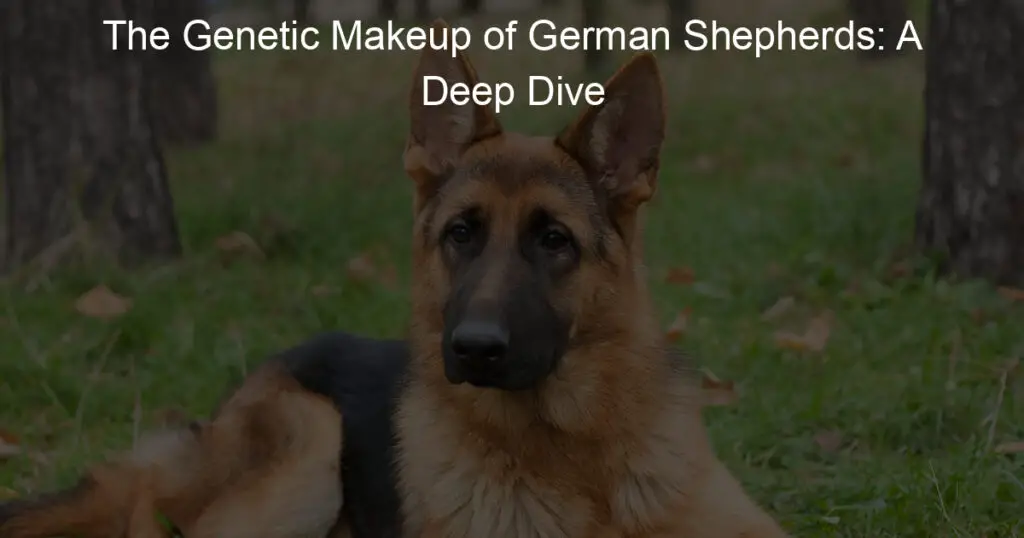The blog post 'The Unique Traits of Female vs. Male German Shepherds' provides an in-depth analysis of the distinct characteristics exhibited by female and male German Shepherds. It emphasizes the physical differences, temperament, training needs, and health issues among other key aspects. The post provides valuable insights for those looking to adopt or buy a German Shepherd, and for current owners eager to understand their pets better.
1. Introduction to the German Shepherd Breed
The German Shepherd breed is well-known and admired for its intelligence, loyalty, and versatility. Originally developed in Germany in the late 19th century, these dogs were initially bred for herding and protecting livestock. Over time, their exceptional working abilities and trainability led to their utilization in various roles such as police, military, and search and rescue work. German Shepherds have a distinctive appearance with a strong, muscular build and a confident and alert expression. They are medium to large-sized dogs, typically weighing between 50 and 90 pounds and standing 22 to 26 inches tall at the shoulder. With their striking appearance and impressive abilities, German Shepherds have gained popularity as both working dogs and family pets. They are known for their unwavering loyalty and protective nature towards their owners, making them excellent guard dogs. German Shepherds are also highly intelligent and quick learners, which makes them well-suited for obedience training and various dog sports. In addition to their physical and mental capabilities, German Shepherds are also known for their distinctive coat. They have a double coat consisting of a dense and weather-resistant outer coat and a soft undercoat. The color of their coat can vary, with the most common colors being black and tan, but they can also be solid black, sable, or even white. Overall, German Shepherds are a remarkable breed that combines strength, intelligence, and loyalty, making them a cherished companion for many dog lovers around the world.
2. 'Are there physical differences?' – Exploring the Physical Traits
When it comes to physical differences between male and female German Shepherds, there are a few noticeable distinctions. Generally, male German Shepherds tend to be larger and heavier than their female counterparts. Males typically weigh between 65 and 90 pounds, while females weigh between 50 and 70 pounds. Similarly, males are usually taller, standing at 24 to 26 inches at the shoulder, while females measure between 22 and 24 inches. These differences in size can be advantageous for specific roles such as protection work or as service dogs, where a larger and more imposing presence is desired.
Another physical difference between male and female German Shepherds is their overall body structure. Males often have a more robust and muscular build, with broader chests and a more prominent head shape. Females, on the other hand, tend to have a slightly more streamlined and feminine appearance. However, it's important to note that these physical differences can vary from dog to dog and are not absolute.
In terms of reproductive traits, female German Shepherds will obviously possess the ability to reproduce and give birth to puppies. On the other hand, male German Shepherds have distinct external reproductive organs, such as the testicles, which are absent in females. These reproductive traits are essential to consider for those interested in breeding German Shepherds.
3. The Size Factor: Weight and Height Differences
When it comes to the size factor, male and female German Shepherds do display distinct differences in terms of weight and height.
- Weight Differences:
Male German Shepherds tend to be heavier compared to females. On average, males can weigh between 65 and 90 pounds, while females typically weigh between 50 and 70 pounds. These weight variations can be attributed to the differences in muscle mass and bone structure between the genders. However, it's important to note that proper nutrition and exercise play crucial roles in maintaining a healthy weight for both male and female German Shepherds. - Height Differences:
In addition to weight, there are also noticeable height differences between male and female German Shepherds. On average, males stand at a shoulder height of 24 to 26 inches, while females measure between 22 and 24 inches. These variations in height can contribute to the overall appearance and presence of the dog. - Implications of Size Differences:
The size differences between male and female German Shepherds can have certain implications in different contexts. For example, male German Shepherds, being larger and heavier, may be more suitable for tasks that require strength and endurance, such as protection work or search and rescue operations. On the other hand, the slightly smaller size of female German Shepherds may allow them to be more agile and versatile in certain activities, like agility training or obedience competitions.
4. Coat Color and Texture Variations
German Shepherds are known for their distinctive coat, which comes in a variety of colors and textures. The coat color and texture can vary between male and female German Shepherds, adding to their individuality and uniqueness.
One common coat color for German Shepherds is the classic black and tan combination. This is seen in both male and female German Shepherds and is often considered the traditional coloration for the breed. However, it's important to note that variations in shades of black and tan can occur.
In addition to the black and tan coat, German Shepherds can also come in other color variations. These include sable, bi-color, and all black. Sable German Shepherds have coats with a mix of black, brown, and tan hairs, giving them a beautiful and distinct appearance.
Another coat color variation is the bi-color, which consists of a predominantly black coat with tan markings on specific areas, such as the face, chest, and legs. All-black German Shepherds, as the name suggests, have solid black coats without any tan or other color markings.
When it comes to coat texture, German Shepherds generally have a double coat. The outer coat is dense and coarse, providing protection from the elements, while the undercoat is soft and insulating. However, there can be slight differences in the texture of the coat between males and females. Some males may have a slightly thicker and longer coat, especially around the neck and chest area.
Regardless of the specific coat color or texture, German Shepherds require regular grooming to keep their coats healthy and clean. This includes brushing to remove loose hair and prevent matting, as well as occasional bathing to maintain their overall hygiene.
5. 'Who's more playful?' – Personality and Temperament
Personality and temperament can vary between male and female German Shepherds, but both genders are known to be energetic and playful. German Shepherds are intelligent and active dogs, and they thrive on mental and physical stimulation. They have a natural curiosity and enjoy exploring their surroundings.
While there may be some individual differences, both male and female German Shepherds tend to be playful and enjoy interactive games, such as fetch or tug-of-war. They have a strong prey drive and love to chase after toys or balls. Their playful nature makes them great companions for families with children or active individuals who enjoy outdoor activities.
However, it's worth noting that male German Shepherds may exhibit slightly more exuberant and boisterous behavior compared to females. They can be more inclined to engage in rough play, which may require extra supervision and training to ensure their playfulness remains appropriate and safe.
On the other hand, female German Shepherds may display a more nurturing and protective side, especially towards their families. They may be more attentive and gentle, making them great companions for households with children or other pets.
Ultimately, the level of playfulness can also depend on individual personalities and training. Proper socialization and training from an early age can help both male and female German Shepherds develop good manners and appropriate play behavior.
6. 'Who's easier to train?' – Intelligence and Trainability
When it comes to intelligence and trainability, both male and female German Shepherds are highly regarded for their aptitude. German Shepherds are known to be one of the most intelligent dog breeds, ranking high in obedience and problem-solving skills. They have a strong desire to please their owners and are quick learners.
In general, German Shepherds are highly trainable and excel in various activities such as obedience training, agility, search and rescue, and even working as service dogs or in law enforcement. Their intelligence allows them to quickly understand and retain commands, making them easier to train compared to some other breeds.
However, it's important to note that individual personality traits and temperaments can also play a role in trainability. Some German Shepherds may have a more independent streak, requiring a firm and consistent training approach. Others may be more sensitive and responsive to positive reinforcement methods.
Additionally, male German Shepherds may exhibit a slightly higher level of dominance and assertiveness compared to females. This can make training a male German Shepherd a bit more challenging, particularly for novice dog owners. It's essential to establish yourself as the pack leader and provide consistent training with clear boundaries and expectations.
On the other hand, female German Shepherds may be more eager to please and may respond well to gentle guidance and positive reinforcement. Their willingness to learn and their strong bond with their owners can make them relatively easier to train.
7. Aggression: Fact or Fiction?
Aggression is a topic that often arises when discussing German Shepherds, but it's important to separate fact from fiction. German Shepherds, regardless of gender, are not inherently aggressive dogs. Like any other breed, their behavior is influenced by various factors such as genetics, socialization, training, and environment.
- 1. Genetics and Breeding:
The temperament and behavior of a German Shepherd can be influenced by its lineage and breeding. Responsible breeders prioritize temperament and work to produce well-balanced, stable dogs. By carefully selecting breeding pairs, they aim to minimize any potential aggression. It's crucial to choose a reputable breeder who focuses on producing German Shepherds with good temperaments. - 2. Socialization and Training:
Proper socialization and training play a significant role in shaping a German Shepherd's behavior. Early exposure to a variety of people, animals, and environments helps them develop into well-rounded dogs. Positive experiences during socialization can prevent fear-based aggression later in life. Additionally, consistent and positive training methods, along with clear boundaries, help establish trust and respect, reducing the likelihood of aggressive behaviors. - 3. Individual Temperament:
While German Shepherds as a breed are not prone to aggression, individual temperament variations can exist. Some German Shepherds may have a more assertive or protective nature, which, if not properly channeled and trained, can manifest as aggression. However, it's crucial to remember that aggression is not exclusive to German Shepherds and can be seen in any breed.
8. Health Concerns in Male and Female German Shepherds
German Shepherds, like any other breed, are prone to certain health concerns that can affect both males and females. However, there are some specific conditions that may be more prevalent in one gender than the other. It's important to be aware of these potential health issues to ensure the well-being of your German Shepherd.
One health concern that is more common in male German Shepherds is testicular cancer. Neutering male dogs at a young age can significantly reduce the risk of this type of cancer. Additionally, males may be more prone to certain orthopedic conditions such as hip dysplasia and elbow dysplasia. Regular exercise, a balanced diet, and maintaining a healthy weight can help minimize the risk and severity of these conditions.
On the other hand, female German Shepherds may be more susceptible to certain reproductive issues. Pyometra, a potentially life-threatening infection of the uterus, is more common in unspayed females. Spaying your female German Shepherd before her first heat cycle greatly reduces the risk of this condition. Mammary tumors, similar to breast cancer in humans, can also occur in intact females but can be prevented by spaying at an early age.
Both male and female German Shepherds can be prone to allergies, skin issues, and gastrointestinal problems. Regular grooming, a healthy diet, and avoiding potential allergens can help manage these conditions. Additionally, German Shepherds, regardless of gender, are susceptible to degenerative myelopathy, a progressive neurological disease that affects their mobility. Regular veterinary check-ups and early detection can help manage this condition.
9. Lifespan Differences – Who Lives Longer?
When it comes to lifespan, both male and female German Shepherds generally have a similar life expectancy. On average, German Shepherds live between 10 and 14 years. However, there can be slight variations in lifespan based on several factors.
One factor that can influence lifespan is genetics. German Shepherds with a lineage of healthy and long-lived ancestors may have a better chance of living a longer life. It's important to choose a reputable breeder who prioritizes the health and longevity of their breeding dogs.
Another factor that can impact lifespan is the overall health and lifestyle of the individual dog. Regular veterinary check-ups, vaccinations, and preventive care are essential in maintaining good health and detecting any potential health issues early on. Providing a balanced diet, regular exercise, and mental stimulation can also contribute to a longer and healthier life.
Additionally, the environment and living conditions can play a role in a German Shepherd's lifespan. Dogs that are well-cared for, have access to a safe and stimulating environment, and receive plenty of love and attention from their owners tend to live longer and happier lives.
While there may not be significant differences in lifespan between male and female German Shepherds, individual variations can occur. Some studies suggest that females may have a slightly longer lifespan, while others show no significant difference. Ultimately, the most important factor in determining a dog's lifespan is the care and attention they receive throughout their lives.
10. 'Are there differences in their feeding habits?' – Diet and Nutrition
German Shepherds, whether male or female, have similar feeding habits and nutritional needs. However, there are a few factors to consider when it comes to their diet and nutrition.
First, German Shepherds are known to have a voracious appetite. They are active dogs with high energy levels, so they require a diet that is rich in protein and balanced with carbohydrates and healthy fats. It's important to provide them with high-quality dog food that is specifically formulated for large and active breeds.
Secondly, portion control is crucial to prevent overeating and obesity. German Shepherds have a tendency to gain weight if not properly monitored. It is recommended to follow the feeding guidelines provided by the dog food manufacturer and adjust the portion size based on your individual dog's activity level, age, and metabolism.
Thirdly, German Shepherds may have specific dietary requirements or sensitivities. Some may be prone to food allergies or digestive issues, so it's important to be aware of any specific dietary needs your dog may have. Consulting with a veterinarian can help determine the best diet and nutrition plan for your German Shepherd.
Finally, it's important to provide fresh water at all times. German Shepherds are active dogs that require proper hydration, especially during exercise or hot weather. Make sure to clean their water bowl regularly to ensure it's free from bacteria or contaminants.
11. Exercise Requirements: Who Needs More?
German Shepherds, whether male or female, are highly active and energetic dogs that require regular exercise to stay happy and healthy. However, there are a few factors to consider when it comes to their exercise requirements.
First, German Shepherds are working dogs with a strong drive to perform tasks and engage in physical activities. They have a natural instinct to work and need mental and physical stimulation on a daily basis. Regular exercise helps them release their energy and prevents them from becoming bored or restless.
Secondly, the exercise needs of German Shepherds may vary based on their age, size, and overall health. Younger German Shepherds, especially puppies, have more energy and require more exercise compared to older dogs. Adult German Shepherds typically need at least 1-2 hours of exercise each day, which can include activities like walking, jogging, playing fetch, or participating in dog sports such as agility or obedience training.
Furthermore, German Shepherds thrive in environments where they have ample space to run and explore. They are not well-suited for apartment living and require access to a secure yard or regular trips to a nearby park. Engaging them in off-leash activities in a safe and controlled environment can further satisfy their exercise needs.
12. Suitability as Family Pets
German Shepherds are known for their loyalty, intelligence, and protective nature, making them well-suited as family pets. They form strong bonds with their owners and are often eager to please. However, it's important to consider a few factors when determining their suitability as family pets.
First, German Shepherds require a lot of attention and socialization from an early age. They thrive in homes where they receive regular interaction and companionship from their family members. They enjoy being a part of the family activities and can be excellent playmates for children.
Secondly, their protective instincts can make them excellent guard dogs, but it also means they may be wary of strangers. Proper training and socialization can help them differentiate between friendly visitors and potential threats. German Shepherds can be protective of their family, which can be a desirable trait for some households, but it's crucial to ensure they are well-trained to prevent any aggressive behaviors.
Finally, German Shepherds are high-energy dogs and need plenty of exercise and mental stimulation. Families considering a German Shepherd as a pet should be prepared to provide regular exercise, playtime, and training sessions. They can excel in activities like agility, obedience, and even search and rescue. Their intelligence and eagerness to learn make them highly trainable, which can be a rewarding experience for both the dog and the family.
13. 'Which one is right for me?' – Making the Right Choice
Deciding whether a male or female German Shepherd is right for you depends on various factors that are unique to your lifestyle and preferences. Here are some considerations to help you make an informed decision:
Firstly, think about the size difference between male and female German Shepherds. Males tend to be larger and more muscular, while females are generally smaller and lighter. If you are looking for a larger, more imposing dog, a male may be the better choice. However, if you prefer a more manageable size or have limited space, a female might be a better fit.
Secondly, consider the energy levels and activity requirements. Both male and female German Shepherds are active and require regular exercise, but males tend to have higher energy levels. If you have an active lifestyle and enjoy outdoor activities like running or hiking, a male may be a great match. On the other hand, if you prefer a slightly calmer companion or have limitations on your physical activity, a female might be a better fit.
Additionally, consider the temperament differences. While individual personalities can vary, male German Shepherds are often more dominant and assertive, while females can be more nurturing and protective. If you are looking for a strong protector or a dog for specific tasks like search and rescue, a male may be a suitable choice. However, if you want a dog that is more gentle and nurturing, a female might be a better fit.
Finally, consider any potential breeding considerations. If you have no intention of breeding your German Shepherd, spaying or neutering is recommended. However, if you are interested in breeding in the future, you may want to consider a male or female based on your breeding goals and responsibilities.
Unique Traits of Female vs. Male German Shepherds:
| Gender | Physical Differences | Temperament | Training Needs |
|---|---|---|---|
| Female | Smaller size, softer coat | More gentle, less territorial | More sensitive, shorter attention span |
| Male | Larger size, thicker coat | More protective, more territorial | More dominant, longer attention span |
| Female | More prone to urinary tract infections | More sensitive, shorter attention span | More gentle, less territorial |
| Male | More prone to hip dysplasia | More dominant, longer attention span | More protective, more territorial |
In conclusion, both female and male German Shepherds exhibit unique traits, each with their own strengths and challenges. While the physical and behavioral differences are important, the health and training needs of the dog also play a crucial role. Understanding these differences can help potential and current owners provide the right environment and care for their pets. Remember, regardless of the sex, every German Shepherd is a loyal, intelligent, and highly trainable dog that makes a great family pet.















